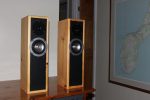Historic VLF (Very Low Frequency) station SAQ Grimeton will be on the air to celebrate United Nations Day on October 24th at 10:30 UTC (6:30 am EST) on 17.2 KHz CW. This station was established in 1922 and is the last radio station in the world employing an Alexanderson transmitter. More information at their website.
This is a great 2011 video of a tour of the station, including transmitter start-up:
It is great to see that old gear come to life and transmit a message. The electric motor/generator sounds like a jet engine spooling up.
Before solid-state or even hollow-state rectifiers, motor generators were used to create the DC voltages needed to transmit high-power radio signals. This method was used by high-powered Naval shore stations through WWII and beyond.
By way of comparison, an average CW operator can send and receive Morse code at about 20-25 words per minute. A good CW operator, about 30 words per minute and a Russian CW operator, somewhere near 50 words per minute. This was the main wireless data transmission method until Radio Teletype came into widespread use in the 1950s. Here is a comparison of data speeds through the years:
| Method | Speed | Bits/S |
| CW | 20 WPM | 8.3 |
| CW | 35 WPM | 14.58 |
| Radio Teletype* | 75 Baud/100 WPM | 41.6 |
| Radio Teletype* | 100 Baud/133 WPM | 55.41 |
| Async data | 300 Baud | 300 |
| Async data | 1200 Baud | 1200 |
| Async data | 9600 Baud | 9600 |
| Switched 56 (Switchway) | 56KB | 56,000 |
| DS0 (POTS) | 64KB | 64,000 |
| ISDN | 64KB X2 | 128,000 |
| DS1 (T-1) | 1.54 MB | 1,540,000 |
| DS3 (T-3) | 45 MB | 45,000,000 |
| Ethernet | 10BaseT | 10,000,000 |
| Ethernet | 100BaseT | 100,000,000 |
| Ethernet | Gigabit | 1,000,000,000 |
The Morse Code (CW) and Radio Teletype data rates are not a direct comparison, as most radio teletype systems use 5-bit Baudot code instead of 8-bit ASCII. Morse code varied in length from one to five bits, if one thinks of each dot or dash as a data bit. Back in the day, before the “Netcentric” mindset, we used mainly radio teletype to communicate from ship to shore. A premium was placed on brief, concise, operational communications. Everything else was sent via the mail.
It is quite amazing to see the increase in data speed, which directly correlates to information exchanged (or the ability to exchange information) in the last 90 years.
To receive SAQ Grimeton, one needs a VLF receiver or converter capable of receiving 17.2 KHz and a very quiet receiver location. There are many VLF hobbyists that will be tuning in.





